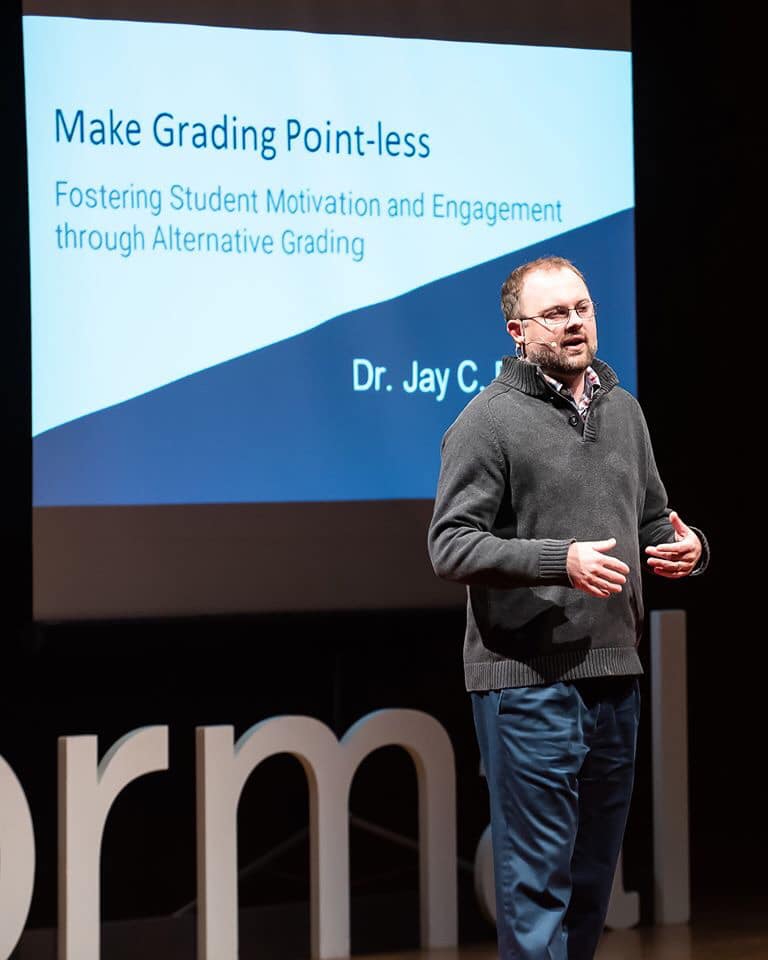Dr. Jay Percell remembers the day it all changed, the day that he started questioning the use of points to assign students’ grades. Percell, an assistant professor in the School of Teaching and Learning, was teaching high school English at the time. It was near the end of the school year and he was assigning a final project before summer vacation.
“I had a student ask how many points it was worth, which is something I had heard a million times before,” he said. “But I could see him calculating his points in his mind, and I knew he was trying to figure out if he had to do the assignment at all or, if he did, just how much effort would he have to put forth? I thought to myself, ‘What’s the point?’ Is this all school is? Just trying to accumulate points by any means necessary?”
Finding answers to these questions directed Percell towards studying alternative grading systems throughout his career, and led to a recent presentation at a TEDxNormal event.
Developing a New System
After experiencing his ‘what’s the point’ moment, Percell focused his dissertation on opportunities for alternative grading. He collaborated with colleague, Lance Huffman, who was going through his own doctoral program at Harvard University at the time. Their research led them towards developing a new grading system that didn’t involve any points at all. Instead, Percell and Huffman focused on a system where they would develop minimum requirements for a particular assignment that students need to meet. However, they would then encourage students to go beyond those minimums to reach a proficiency or mastery level.
The goal was to get students to use their own creative thinking to make their work unique. Students would submit their original work, receive feedback, and decide to either keep their original score or resubmit it for a better score. In this grading system, students had a total of three chances to improve their work and make it the highest quality possible, rather than the traditional model of submitting an assignment for a one-time grade.
According to Percell, “It was more based on quality of work and different tiers that students could achieve that would determine their grade. We tried to qualitatively reconceptualize what each letter grade meant. It certainly changed and evolved over the semester but my trial run was just with one class of seniors. My thought was that, if anyone could handle it, it was the seniors.”
Implementing No Points
Developing and utilizing a new grading structure was challenging at the beginning. There was pushback from students who were used to the same old grading system, from parents who were trying to understand what their students needed to do, and from administration who were supportive but also concerned about how these grades would be able to fit within other school reporting needs. This was especially concerning at the beginning of the school year when limited grades were available.
Percell describes the freeing aspect of getting students away from just going through the motions and thinking for themselves.
“That whole chasing the points game was all gone now. And now we could just focus about the learning and the content of the course,” he said.
Percell has refined the system through his years teaching high school English, and has continued to use a version of it in his college classroom. He came to Illinois State University in 2010, initially as an adjunct faculty member, and then secured a tenure line position primarily teaching courses in secondary education.
Several teachers have also approached him to share how this grading system can be applied in their classrooms. Many are former students who experienced it firsthand and are now teachers themselves. Percell shared his grading system with community members at the TEDxNormal event on November 16, 2019.
“This event was very inspiring, and I felt honored to be a part of it,” he said. “My talk spurred some excellent follow up discussion, and I think people were able to relate to it just from their own previous experience as a student.”
For a more complete description of Percell’s work with alternative grading systems, watch his entire TEDxNormal presentation available below.
“My goal with all of this work is to get students away from just going through the motions and getting them to think for themselves,” he said. “To keep from just telling them exactly what I want, and asking them what they can do to make their work stand out. And that’s the point.”

